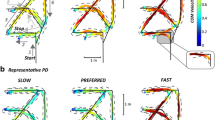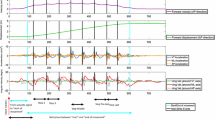Abstract
The degeneration of postural control in the elderly and patients with Parkinson’s disease (PD) can be debilitating and may lead to increased fall risk. This study evaluated the changes in postural control during gait affected by PD and aging using a new method based on the General Tau Theory. Fifteen patients with PD, 11 healthy old adults (HOs), and 15 healthy young adults (HYs) were recruited. Foot trajectories of each participant were monitored during walking by a three-camera Optotrak Certus® motion capture system. The anteroposterior direction of foot movement during stepping was analyzed by tau-G and tau-J guidance strategies. Two linear regression analyses suggested that the tau of the step-gap was strongly coupled onto the tau-J guidance during walking. The regression slope K could estimate the coupling ratio in the tau-coupling equation which reflects the performance of postural control during gait. The mean K value for the PD group, which was highest among the three groups, was approximately 0.5. Therefore, participants in the PD group walked with the poorest postural control and exhibited a relatively hard contact with the endpoint during stepping when compared with those in the HO and HY groups. The HY and HO groups obtained mean K values significantly lower than 0.5, which indicated that the gait was well controlled and ended at low speed with low deceleration. However, the HO group showed a decreased tendency for postural control, in which the mean K value was significantly higher than that of the HY group. The K value was moderately positively correlated with the double support time and negatively correlated with the stride length and walking speed. The tau-J coupling ratio can provide additional insight into gait disturbances and may serve as a reliable, objective, and quantitative tool to evaluate dynamic postural control during walking.






Similar content being viewed by others
References
Adkin AL, Frank JS, Jog MS (2003) Fear of falling and postural control in Parkinson’s disease. Mov Disord 18:496–502. doi:10.1002/mds.10396
Austad H, van der Meer ALH (2007) Prospective dynamic balance control in healthy children and adults. Exp Brain Res 181:289–295. doi:10.1007/s00221-007-0932-1
Benatru I, Vaugoyeau M, Azulay JP (2008) Postural disorders in Parkinson’s disease. Neurophysiol Clin/Clin Neurophysiol 38:459–465. doi:10.1016/j.neucli.2008.07.006
Blin O, Ferrandez AM, Serratrice G (1990) Quantitative analysis of gait in Parkinson patients: increased variability of stride length. J Neurol Sci 98:91–97
Bloem BR, Beckley DJ, van Hilten BJ, Roos RAC (1998) Clinimetrics of postural instability in Parkinson’s disease. J Neurol 245:669–673. doi:10.1007/s004150050265
Bronte-Stewart HM, Minn AY, Rodrigues K, Buckley EL, Nashner LM (2002) Postural instability in idiopathic Parkinson’s disease: the role of medication and unilateral pallidotomy. Brain 125:2100–2114. doi:10.1093/brain/awf207
Caetano MJD, Gobbi LTB, Sanchez-Arias MD, Stella F, Gobbi S (2009) Effects of postural threat on walking features of Parkinson’s disease patients. Neurosci Lett 452:136–140. doi:10.1016/j.neulet.2009.01.053
Craig CM, Delay D, Grealy MA, Lee DN (2000) Guiding the swing in golf putting. Nature 405:295–296. doi:10.1038/35012690
Dibble LE, Lange M (2006) Predicting falls in individuals with Parkinson disease: a reconsideration of clinical balance measures. J Neurol Phys Ther 30:60–67
Dingwell JB, Cusumano JP, Cavanagh PR, Sternad D (2001) Local dynamic stability versus kinematic variability of continuous overground and treadmill walking. J Biomech Eng 123:27–32. doi:10.1115/1.1336798
Frank JS, Horak FB, Nutt J (2000) Centrally initiated postural adjustments in parkinsonian patients on and off levodopa. J Neurophysiol 84:2440–2448
Gabell A, Nayak US (1984) The effect of age on variability in gait. J Gerontol 39:662–666
Gazzola JM, Perracini MR, Gananca MM, Gananca FF (2006) Functional balance associated factors in the elderly with chronic vestibular disorder. Braz J Otorhinolaryngol 72:683–690
Hamani C, Lozano AM (2003) Physiology and pathophysiology of Parkinson’s disease. In: Federoff HJ, Burke RE, Fahn S, Fiskum G (eds) Parkinson’s disease: the life cycle of the dopamine neuron. New York Acad Sciences, New York, pp 15–21
Hass CJ, Malczak P, Nocera J et al (2012) Quantitative normative gait data in a large cohort of ambulatory persons with Parkinson’s disease. PLoS ONE 7:e42337. doi:10.1371/journal.pone.0042337
Hausdorff JM, Rios DA, Edelberg HK (2001) Gait variability and fall risk in community-living older adults: a 1-year prospective study. Arch Phys Med Rehabil 82:1050–1056. doi:10.1053/apmr.2001.24893
Hermann W (1982) Flow-field variables trigger landing in flies. Nature 297:147
Horak FB, Wrisley DM, Frank J (2009) The balance evaluation systems test (BESTest) to differentiate balance deficits. Phys Ther 89:484–498. doi:10.2522/ptj.20080071
Jankovic J (2008) Parkinson’s disease: clinical features and diagnosis. J Neurol Neurosurg Psychiatry 79:368–376. doi:10.1136/jnnp.2007.131045
Kemoun G, Thoumie P, Boisson D, Guieu JD (2002) Ankle dorsiflexion delay can predict falls in the elderly. J Rehabil Med 34:278–283. doi:10.1080/165019702760390374
Khudados E, Cody FWJ, O’Boyle DJ (1999) Proprioceptive regulation of voluntary ankle movements, demonstrated using muscle vibration, is impaired by Parkinson’s disease. J Neurol Neurosurg Psychiatry 67:504–510. doi:10.1136/jnnp.67.4.504
Kim S, Horak FB, Carlson-Kuhta P, Park S (2009) Postural feedback scaling deficits in Parkinson’s disease. J Neurophysiol 102:2910–2920. doi:10.1152/jn.00206.2009
Lee DN (1976) A theory of visual control of braking based on information about time-to-collision. Perception 5:437–459
Lee DN (1998) Guiding movement by coupling taus. Ecol Psychol 10:221–250. doi:10.1207/s15326969eco103&4_4
Lee DN (2009) General Tau Theory: evolution to date. Perception 38:837–850
Lee DN, Craig CM, Grealy MA (1999) Sensory and intrinsic coordination of movement. Proc Biol Sci 266:2029–2035. doi:10.1098/rspb.1999.0882
Lee D, Georgopoulos A, Clark M, Craig C, Port N (2001) Guiding contact by coupling the taus of gaps. Exp Brain Res 139:151–159. doi:10.1007/s002210100725
Lewis GN, Byblow WD, Walt SE (2000) Stride length regulation in Parkinson’s disease: the use of extrinsic, visual cues. Brain 123:2077–2090. doi:10.1093/brain/123.10.2077
Lewis SJG, Dove A, Robbins TW, Barker RA, Owen AM (2003) Cognitive impairments in early Parkinson’s disease are accompanied by reductions in activity in frontostriatal neural circuitry. J Neurosci 23:6351–6356
Lynn MS (2012) TauG-guidance of dynamic balance control during gait initiation across adulthood. Gait Posture 36:523–526
Mancini M, Carlson-Kuhta P, Zampieri C, Nutt JG, Chiari L, Horak FB (2012a) Postural sway as a marker of progression in Parkinson’s disease: a pilot longitudinal study. Gait Posture 36:471–476. doi:10.1016/j.gaitpost.2012.04.010
Mancini M, Salarian A, Carlson-Kuhta P, Zampieri C, King L, Chiari L, Horak FB (2012b) ISway: a sensitive, valid and reliable measure of postural control. J Neuroeng Rehabil 9:8. doi:10.1186/1743-0003-9-59
Maschke M, Gomez CM, Tuite PJ, Konczak J (2003) Dysfunction of the basal ganglia, but not the cerebellum, impairs kinaesthesia. Brain 126:2312–2322. doi:10.1093/brain/awg230
Moghadam M, Ashayeri H, Salavati M, Sarafzadeh J, Taghipoor KD, Saeedi A, Salehi R (2011) Reliability of center of pressure measures of postural stability in healthy older adults: effects of postural task difficulty and cognitive load. Gait Posture 33:651–655. doi:10.1016/j.gaitpost.2011.02.016
Morris ME, Iansek R, Matyas TA, Summers JJ (1996a) Stride length regulation in Parkinson’s disease. Normalization strategies and underlying mechanisms. Brain 119(Pt 2):551–568. doi:10.1093/brain/119.2.551
Morris ME, Matyas TA, Iansek R, Summers JJ (1996b) Temporal stability of gait in Parkinson’s disease. Phys Ther 76:763–777
Nicholas H (1995) Elementary computation of object approach by a wide-field visual neuron. Science 270:1000–1003
Nordin E, Moe-Nilssen R, Ramnemark A, Lundin-Olsson L (2010) Changes in step-width during dual-task walking predicts falls. Gait Posture 32:92–97. doi:10.1016/j.gaitpost.2010.03.012
Pastor MA, Day BL, Marsden CD (1993) Vestibular induced postural responses in Parkinson’s disease. Brain 116(Pt 5):1177–1190. doi:10.1093/brain/116.5.1177
Patterson SL, Forrester LW, Rodgers MM, Ryan AS, Ivey FM, Sorkin JD, Macko RF (2007) Determinants of walking function after stroke: differences by deficit severity. Arch Phys Med Rehabil 88:115–119. doi:10.1016/j.apmr.2006.10.025
Rinalduzzi S, Trompetto C, Marinelli L et al (2015) Balance dysfunction in Parkinson’s disease. BioMed Res Int 2015:434683. doi:10.1155/2015/434683
Ringsberg K, Gerdhem P, Johansson J, Obrant KJ (1999) Is there a relationship between balance, gait performance and muscular strength in 75-year-old women? Age Ageing 28:289–293. doi:10.1093/ageing/28.3.289
Schogler B, Pepping G-J, Lee D (2008) TauG-guidance of transients in expressive musical performance. Exp Brain Res 189:361–372. doi:10.1007/s00221-008-1431-8
Shimada H, Obuchi S, Kamide N, Shiba Y, Okamoto M, Kakurai S (2003) Relationship with dynamic balance function during standing and walking. Am J Phys Med Rehabil 82:511–516. doi:10.1097/01.phm.0000064726.59036.cb
Sun HJ, Frost BJ (1998) Computation of different optical variables of looming objects in pigeon nucleus rotundus neurons. Nat Neurosci 1:296–303
Svehlik M, Zwick EB, Steinwender G et al (2009) Gait analysis in patients with Parkinson’s disease off dopaminergic therapy. Arch Phys Med Rehabil 90:1880–1886. doi:10.1016/j.apmr.2009.06.017
Taylor ME, Ketels MM, Delbaere K, Lord SR, Mikolaizak AS, Close JCT (2012) Gait impairment and falls in cognitively impaired older adults: an explanatory model of sensorimotor and neuropsychological mediators. Age Ageing 41:665–669. doi:10.1093/ageing/afs057
van der Weel FR, van der Meer ALH, Lee DN (1996) Measuring dysfunction of basic movement control in cerebral palsy. Hum Mov Sci 15:253–283. doi:10.1016/0167-9457(95)00046-1
Wen L, Qian J, Hu X, Shen L, Wu X, Yu C (2013) Gait measurement and quantitative analysis in patients with Parkinson’s disease for rehabilitation assessment. 2013 IEEE international conference on robotics and biomimetics, ROBIO 2013, December 12, 2013–December 14, 2013. IEEE Computer Society, Shenzhen, pp 286–291
Williams DR, Watt HC, Lees AJ (2006) Predictors of falls and fractures in bradykinetic rigid syndromes: a retrospective study. J Neurol Neurosurg Psychiatry 77:468–473. doi:10.1136/jnnp.2005.074070
Winter DA (1992) Foot trajectory in human gait: a precise and multifactorial motor control task. Phys Ther 72:45–53 (discussion 54–46)
Winter DA (1995) Human balance and posture control during standing and walking. Gait Posture 3:193–214. doi:10.1016/0966-6362(96)82849-9
Zhang S, Zhang Z, Qian J (2014a) Bio-inspired trajectory planning for robot catching movements based on Tau theory. Jixie Gongcheng Xuebao/J Mech Eng 50:42–51. doi:10.3901/JME.2014.13.042
Zhang Z, Zhang ST, Xie P, Ma O (2014b) Bioinspired 4D trajectory generation for a UAS rapid point-to-point movement. J Bionic Eng 11:72–81. doi:10.1016/s1672-6529(14)60021-4
Acknowledgments
This study was supported by The National Natural Science Foundation of China (Award No. 51275282) and the PhD Programs Foundation of Ministry of Education of China (Award No. 20123108110009). We thank the volunteers for participating in this study. We are grateful to Changlin Yu and Liuyang Wu for their assistance in data collection.
Author information
Authors and Affiliations
Corresponding author
Ethics declarations
Conflict of interest
The authors declare that they have no conflict of interest.
Rights and permissions
About this article
Cite this article
Zhang, S., Qian, J., Zhang, Z. et al. Age- and Parkinson’s disease-related evaluation of gait by General Tau Theory. Exp Brain Res 234, 2829–2840 (2016). https://doi.org/10.1007/s00221-016-4685-6
Received:
Accepted:
Published:
Issue Date:
DOI: https://doi.org/10.1007/s00221-016-4685-6




